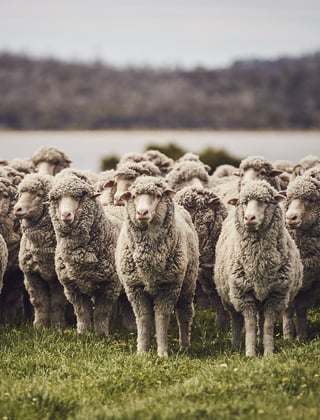Resilience shown by wool trade at IWTO

AWI Global Strategic Advisor Peter Ackroyd reports on some items of interest from the recent IWTO Congress in Adelaide and the current mood in the wool textile trade. Mr Ackroyd is a former President of the International Wool Textile Organisation and is Chief Operating Officer of the Campaign for Wool.
EU Product Environmental Footprint (PEF): IWTO is currently making common cause with cotton and other natural fibres in a quest to make the Make the Label Count campaign really count. This relatively new development was well amplified at the IWTO Congress in Adelaide by IWTO President Klaus Steger. Perhaps it required taking a closer look at key retail players in the PEF consultative process to remind the trade of the seemingly bottomless pit of cash and resources available to those in the global textile industry that would seek to discredit wool’s reputation in fashion and lifestyle. The membership list of Cascale (formerly known as the Sustainable Apparel Coalition) reads like a rogue’s gallery of the environmentally irresponsible, with funding that wool could only dream of for its fight for a fair hearing in the corridors of power in Brussels and beyond.
Global sustainability standards for wool: At the opening IWTO Executive Committee meeting in Adelaide, chairman of the Italian weaving company Reda, Francesco Botto Poala, reported on the recent formation of a dedicated Wool Section within the Italian textile and fashion association Sistema Moda Italia (SMI). A positive consequence of the formation of the SMI Wool Section is that it has made a commitment of €100,000 (about A$163,000) per year for three years to IWTO for approved projects. The Italian group stressed the recent granting of €100,000 per annum for IWTO project funding should be in part dedicated to the creation of an IWTO Green Book that would be ‘a compendium of protocols and definitions pertaining to supply chain integrity from farm to fashion’. Content of the proposed Green Book is currently under discussion, but some draft guidelines have already been compiled.
Industry marketing strategies: If the Retail Forum at IWTO in Adelaide had been put together specifically to show woolgrowers and their trading partners, representatives and associations that effective marketing strategies are currently in place at The Woolmark Company and elsewhere, it was, according to a number of attendees not known for holding back, particularly successful. Presentations were provided on consumer marketing by The Woolmark Company’s General Manager of Marketing Communications, Laura Armstrong; casualisation vs formal wear by Managing Director of Dormeuil in Paris, Richard Boidé; high performance apparel and environmental management by Executive Director of Prada, Lorenzo Bertelli; social media impacts on the consumer by designer Dion Lee; online vs bricks-and-mortar by Senior Manager at Huckberry, Jeremy Berres-Paul; and merchandising to the consumer by Head of Buying at APG/Sportscraft, Alex Kidis; as well as my own presentation on the world of retail, consumer trends and impacts on wool.
Broader micron wool: The strong wool sector was encouraged by the presence in Adelaide of the New Zealand Associate Agriculture Minister, Hon Mark Patterson, who repeated his government’s commitment to prioritise wool in public sector work, particularly in floor coverings in state schools and public buildings. If this edict is carried out as the New Zealand wool community believes it will be, it should give some long awaited comfort to the beleaguered strong wool sector.
Cautious optimism in the wool textile trade: The mood in the wool textile trade, following the recent round of textile trade fairs, is one of cautious optimism as orders for winter 2024/25 in the Northen Hemisphere begin to reach spinners and weavers, albeit with a certain reticence. There is hope that activity will begin to pick up in June after several months of uncertainty following the post-Covid surge. Whilst disturbing levels of uncertainty exist in some sectors of the wool textile processing pipeline, the industry seems relatively resilient in the face of headwinds including the situation in Ukraine, the Red Sea and Gaza, fuelled by persistent inflation and a relatively soft labour market in countries that count. Time will tell, as winter yarn and fabric orders begin to be confirmed and stocks continue to move, albeit sluggishly, at retail. One message is abundantly clear: the apparel market is continuing to polarise and it gives grounds for cautious optimism that several retailers that can shift volumes clearly see their future lies in the better end of the business.
Trade shows still below pre-Covid levels: Seasonal textile trade shows forced to shut down for four seasons during Covid, are still striving to return to 2019 levels in terms of exhibitors and visitors. The European woollen and worsted spinning and weaving industry has voted key events for wool processors post pandemic in Europe to be: Pitti Immagine Filati, a machine knitting yarn show held in February and June in Florence; Milano Unica, a fabric event held in February and June; and Première Vision a fabric and CMT (Cut, Make, Trim) garment manufacturing event held in Paris each July and February. It is estimated these events are currently operating at 80% pre-Covid levels. Exhibitors at recent fabric fairs noted greater quality footfall in both Milan and Paris.
12+ month textile cycle: The seasonal textile cycle has changed little over the years. For the all-important Northern Hemisphere winter season for wool, the calendar remains roughly the same: sample swatches and model garment lengths are selected from July to September; weavers await initial bulk piece orders being placed January to April; garments are produced May to July; and goods are in store for the Northern Hemisphere winter in early September. Upcoming textile trade shows for autumn/winter 2025/26 in Europe, where Woolmark licensees will be showing yarn collections at Pitti Immagine Filati in Florence and fabric collections at Milano Unica in Milan and Première Vision in Paris, are viewed by all in the processing pipeline as pivotal to any predicted upturn in what is currently, a decidedly morose market.
This article appeared in the June 2024 edition of AWI’s Beyond the Bale magazine. Reproduction of the article is encouraged.














